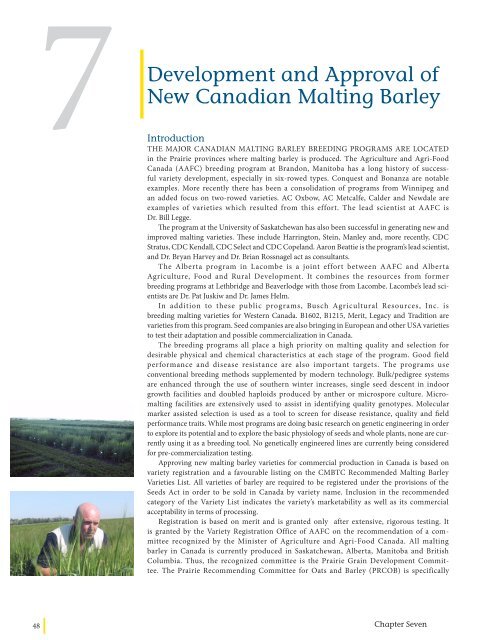MALTING QUALITY TRAITS - Canadian Malting Barley Technical ...
MALTING QUALITY TRAITS - Canadian Malting Barley Technical ...
MALTING QUALITY TRAITS - Canadian Malting Barley Technical ...
You also want an ePaper? Increase the reach of your titles
YUMPU automatically turns print PDFs into web optimized ePapers that Google loves.
7 Introduction<br />
THE MAJOR CANADIAN <strong>MALTING</strong> BARLEY BREEDING PROGRAMS ARE LOCATED<br />
48<br />
Development and Approval of<br />
New <strong>Canadian</strong> <strong>Malting</strong> <strong>Barley</strong><br />
in the Prairie provinces where malting barley is produced. The Agriculture and Agri-Food<br />
Canada (AAFC) breeding program at Brandon, Manitoba has a long history of successful<br />
variety development, especially in six-rowed types. Conquest and Bonanza are notable<br />
examples. More recently there has been a consolidation of programs from Winnipeg and<br />
an added focus on two-rowed varieties. AC Oxbow, AC Metcalfe, Calder and Newdale are<br />
examples of varieties which resulted from this effort. The lead scientist at AAFC is<br />
Dr. Bill Legge.<br />
The program at the University of Saskatchewan has also been successful in generating new and<br />
improved malting varieties. These include Harrington, Stein, Manley and, more recently, CDC<br />
Stratus, CDC Kendall, CDC Select and CDC Copeland. Aaron Beattie is the program’s lead scientist,<br />
and Dr. Bryan Harvey and Dr. Brian Rossnagel act as consultants.<br />
The Alberta program in Lacombe is a joint effort between AAFC and Alberta<br />
Agriculture, Food and Rural Development. It combines the resources from former<br />
breeding programs at Lethbridge and Beaverlodge with those from Lacombe. Lacombe’s lead scientists<br />
are Dr. Pat Juskiw and Dr. James Helm.<br />
In addition to these public programs, Busch Agricultural Resources, Inc. is<br />
breeding malting varieties for Western Canada. B1602, B1215, Merit, Legacy and Tradition are<br />
varieties from this program. Seed companies are also bringing in European and other USA varieties<br />
to test their adaptation and possible commercialization in Canada.<br />
The breeding programs all place a high priority on malting quality and selection for<br />
desirable physical and chemical characteristics at each stage of the program. Good field<br />
performance and disease resistance are also important targets. The programs use<br />
conventional breeding methods supplemented by modern technology. Bulk/pedigree systems<br />
are enhanced through the use of southern winter increases, single seed descent in indoor<br />
growth facilities and doubled haploids produced by anther or microspore culture. Micromalting<br />
facilities are extensively used to assist in identifying quality genotypes. Molecular<br />
marker assisted selection is used as a tool to screen for disease resistance, quality and field<br />
performance traits. While most programs are doing basic research on genetic engineering in order<br />
to explore its potential and to explore the basic physiology of seeds and whole plants, none are currently<br />
using it as a breeding tool. No genetically engineered lines are currently being considered<br />
for pre-commercialization testing.<br />
Approving new malting barley varieties for commercial production in Canada is based on<br />
variety registration and a favourable listing on the CMBTC Recommended <strong>Malting</strong> <strong>Barley</strong><br />
Varieties List. All varieties of barley are required to be registered under the provisions of the<br />
Seeds Act in order to be sold in Canada by variety name. Inclusion in the recommended<br />
category of the Variety List indicates the variety’s marketability as well as its commercial<br />
acceptability in terms of processing.<br />
Registration is based on merit and is granted only after extensive, rigorous testing. It<br />
is granted by the Variety Registration Office of AAFC on the recommendation of a committee<br />
recognized by the Minister of Agriculture and Agri-Food Canada. All malting<br />
barley in Canada is currently produced in Saskatchewan, Alberta, Manitoba and British<br />
Columbia. Thus, the recognized committee is the Prairie Grain Development Committee.<br />
The Prairie Recommending Committee for Oats and <strong>Barley</strong> (PRCOB) is specifically<br />
Chapter Seven


